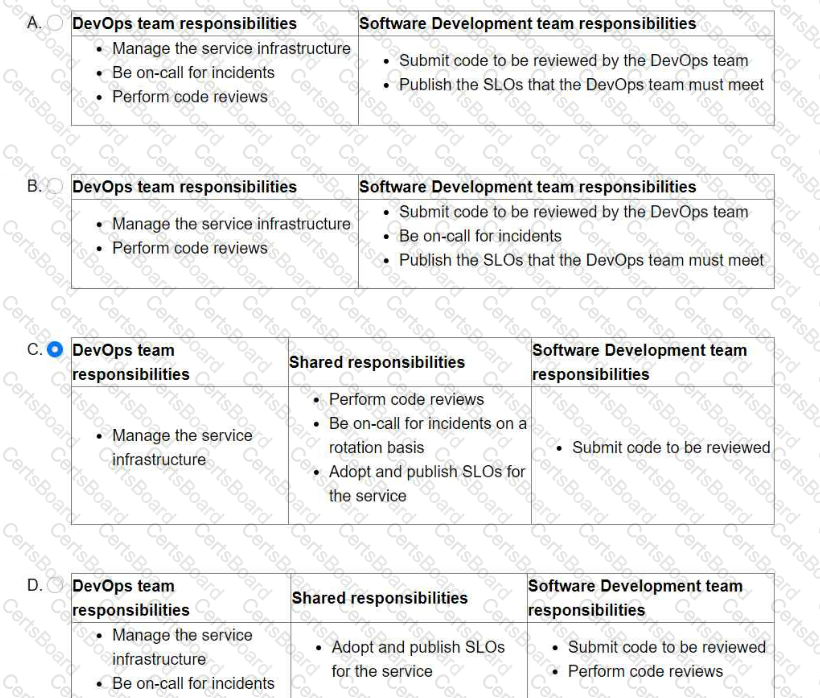You are leading a DevOps project for your organization. The DevOps team is responsible for managing the service infrastructure and being on-call for incidents. The Software Development team is responsible for writing, submitting, and reviewing code. Neither team has any published SLOs. You want to design a new joint-ownership model for a service between the DevOps team and the Software Development team. Which responsibilities should be assigned to each team in the new joint-ownership model?

A third-party application needs to have a service account key to work properly When you try to export the key from your cloud project you receive an error "The organization policy constraint larn.disableServiceAccountKeyCreation is enforcedM You need to make the third-party application work while following Google-recommended security practices What should you do?
You support an e-commerce application that runs on a large Google Kubernetes Engine (GKE) cluster deployed on-premises and on Google Cloud Platform. The application consists of microservices that run in containers. You want to identify containers that are using the most CPU and memory. What should you do?
You recently deployed your application in Google Kubernetes Engine (GKE) and now need to release a new version of the application You need the ability to instantly roll back to the previous version of the application in case there are issues with the new version Which deployment model should you use?
The new version of your containerized application has been tested and is ready to be deployed to production on Google Kubernetes Engine (GKE) You could not fully load-test the new version in your pre-production environment and you need to ensure that the application does not have performance problems after deployment Your deployment must be automated What should you do?
You support a large service with a well-defined Service Level Objective (SLO). The development team deploys new releases of the service multiple times a week. If a major incident causes the service to miss its SLO, you want the development team to shift its focus from working on features to improving service reliability. What should you do before a major incident occurs?
Your team deploys applications to three Google Kubernetes Engine (GKE) environments development staging and production You use GitHub reposrtones as your source of truth You need to ensure that the three environments are consistent You want to follow Google-recommended practices to enforce and install network policies and a logging DaemonSet on all the GKE clusters in those environments What should you do?
You are developing the deployment and testing strategies for your CI/CD pipeline in Google Cloud You must be able to
• Reduce the complexity of release deployments and minimize the duration of deployment rollbacks
• Test real production traffic with a gradual increase in the number of affected users
You want to select a deployment and testing strategy that meets your requirements What should you do?
Your application runs on Google Cloud Platform (GCP). You need to implement Jenkins for deploying application releases to GCP. You want to streamline the release process, lower operational toil, and keep user data secure. What should you do?
You are running an application on Compute Engine and collecting logs through Stackdriver. You discover that some personally identifiable information (PII) is leaking into certain log entry fields. You want to prevent these fields from being written in new log entries as quickly as possible. What should you do?


